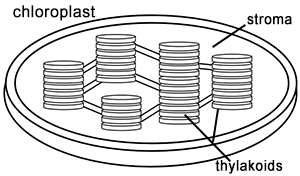Chemiosmosis - ATP Synthesis in Chloroplasts
Photosynthesis is a process that takes place in the leaves of plants where carbon dioxide and water is converted to carbohydrates, also producing oxygen. This process occurs within the chloroplasts, on the thylakoid membranes that are stacked into structures called grana.
In this exercise you will examine the process of ATP synthesis that occurs within the chloroplasts. Read each step carefully and color according to the directions. Remember the goal is to try to understand the process, coloring it is just the tool to help you understand it. Each box shown indicates a pause point where you go to the diagram and color the associated structure.

1. The thylakoid membrane is composed of a phospholipid bilayer (color phospholipids "B" light blue) ![]() with an interior space and an exterior, called the stroma. Photosynthesis takes place in two systems: photosystem I (P1) and photosystem II (P2).
with an interior space and an exterior, called the stroma. Photosynthesis takes place in two systems: photosystem I (P1) and photosystem II (P2). 
2. The first event is the capturing of light energy (color E orange)  by pigments in the membrane. Color the pigments of Photosystem II (P2) and p680 dark green
by pigments in the membrane. Color the pigments of Photosystem II (P2) and p680 dark green  . Color the pigments of Photosystem I (P1) and p700 light green
. Color the pigments of Photosystem I (P1) and p700 light green  .
.
3. When a photon of light strikes the reaction center of Photosystem II, it excites an electron. Two water molecules split into hydrogen ions (protons) and release oxygen. Color the protons (H+) yellow and the oxygen atoms (O2) red  . This process is called PHOTOLYSIS and is illustrated by the arrows labeled "L", which you should color pink.
. This process is called PHOTOLYSIS and is illustrated by the arrows labeled "L", which you should color pink. 
4. Two electrons are released in this process, and these electrons can be traced through photosystem II and photosystem I. The electrons (e) and the path shown as a series of arrows (X) should be colored gray  .
.
5. The primary electron acceptor for the light-energized electrons leaving photosystem II is plastoquinone (color PQ purple) . PQ then passes the electrons to a proton pump embedded in the membrane called the b6-f complex (color dark blue).
. PQ then passes the electrons to a proton pump embedded in the membrane called the b6-f complex (color dark blue). 
6. This proton pump moves protons (H+) atoms across the membrane against their concentration gradients, which eventually causes a build-up of protons in the thylakoid interior. Color the proton path shown as an arrow (y) yellow. 
7. The protons will exit the thylakoid space via a special channel provided by ATP Synthase (color "S" pink)  . The protons move with the concentration gradient, which allows them to do work- namely drive ATP synthesis. Imagine ATP synthase is like water wheel, as protons move by diffusion, the energy created allows them to do work. This process is called CHEMIOSMOSIS.
. The protons move with the concentration gradient, which allows them to do work- namely drive ATP synthesis. Imagine ATP synthase is like water wheel, as protons move by diffusion, the energy created allows them to do work. This process is called CHEMIOSMOSIS.
8. The work that is done is that ADP is phosphorylated into ATP and released into the stroma. The process of making ATP is called PHOTOPHOSPHORYLATION. Color ATP, ADP and the process (Z) orange  . The ATP generated will head to the Calvin Cycle where it will be used to generate glucose.
. The ATP generated will head to the Calvin Cycle where it will be used to generate glucose.
9. But wait, there's more! The electron that was used in Photosystem II is just sitting around, all de-energized but its story is not finished. A small protein called plastocyanin, Pc, (color brown)  carries the electron to Photosystem I. Light absorbed by photosystem I energizes this electron and passes it to another primary electron acceptor called ferredoxin (color "Fd" turquoise)
carries the electron to Photosystem I. Light absorbed by photosystem I energizes this electron and passes it to another primary electron acceptor called ferredoxin (color "Fd" turquoise)  .
.
10 . The enzyme NADP Reductase (color "R" dark purple)  transfers these electrons to NADP from NADPH. The electron is now on its way to the Calvin Cycle as part of an NADPH molecule (color light purple)
transfers these electrons to NADP from NADPH. The electron is now on its way to the Calvin Cycle as part of an NADPH molecule (color light purple)  .
.
Questions:
1. Explain the role of each of the following in 5 words or less.
---- P680 and P700
---- Plastocyanin
---- Plastoquinone
---- NADP Reductase
---- ATP Synthase
2. What is the first step in photosynthesis?
3. Chemiosmosis refers to the process of moving ions (protons) to the other side of the membrane resulting in an electrochemical gradient. What is the gradient used for in the light dependent reaction?
4. Some herbicides work as Photosystem I inhibitors. They work by stealing electrons from their usual route in that system. Why would that kill the plant?
5. Summarize what happens in Ohotosystem I and and Photosystem II.
| Pigments | What Goes In | What Comes Out | Where does it occur | |
| Photosystem I |
|
|
||
| Photosystem II |
|

Other Resources on Photosynthesis
Flower Coloring – color the parts of a flower; stamen, pistil, ovary, petals
Leaf Coloring – color structures; xylem, phloem, bundle sheath, epidermis, and more.
How Do Chloroplasts Capture Energy – coloring and reading worksheet focus on equation for photosynthesis and production of ATP
Reinforcement: Photosynthesis – practice vocabulary with a list of terms and definitions

